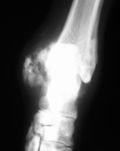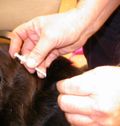 Here's Mollie. [Sorry the photo is a little out of focus; our timeline got way out of hand and I didn't take time to check the picture before she left.] She's a complicated case and she got me to violate one of my basic rules, to wit: I'm a doctor for the whole patient, not just one complaint.
Here's Mollie. [Sorry the photo is a little out of focus; our timeline got way out of hand and I didn't take time to check the picture before she left.] She's a complicated case and she got me to violate one of my basic rules, to wit: I'm a doctor for the whole patient, not just one complaint.
By this I mean that each patient gets a complete physical exam and I try to get a complete medical history. I don't want a patient to come in with three problems and leave with two of them undetected. I didn't realize I was violating it when Mollie first came in, but I did it anyway.
 I hadn't seen Mollie before and she had a number of complaints. She is taking two medications for a seizure disorder (a long-term situation). She has lost weight. Her belly is kind of big. She has some lameness problems, which appear to be related to this lump on her left hind leg. The lump was very hard, so we took this X-ray, and it is not pretty. It's hard to say whether this is bone cancer or bone infection or what, but it's not pretty. With a possibly cancerous lump and weight loss, our next step was a chest X-ray. If her lungs were already riddled with cancer, then our other testing would not be quite as important.
I hadn't seen Mollie before and she had a number of complaints. She is taking two medications for a seizure disorder (a long-term situation). She has lost weight. Her belly is kind of big. She has some lameness problems, which appear to be related to this lump on her left hind leg. The lump was very hard, so we took this X-ray, and it is not pretty. It's hard to say whether this is bone cancer or bone infection or what, but it's not pretty. With a possibly cancerous lump and weight loss, our next step was a chest X-ray. If her lungs were already riddled with cancer, then our other testing would not be quite as important.
Fortunately, the chest X-rays looked great. Next step would be to biopsy that lump. PLUS, we really need to assess how the rest of the body is doing. With that weight loss, other organs could be affected. We need to X-ray the abdomen and get an ultra-sound scan. And, of course, we should really get some blood-work. The owner looked at the estimate and decided she wanted the biopsy first and the rest could wait, and I acquiesced.
Now friends, I want to take time out to talk to you about what we call the "minimum database". Actually, it's what the veterinary teaching hospital calls the "minimum database". Any patient admitted will have a complete blood count, blood chemistry profile, urinalysis, and stool exam. That might sound more like a "maximum database" instead of a "minimum database". I certainly don't always have the opportunity to get all that information with every patient. Of course, with a referral institution, with cases that have already been worked up elsewhere, you surely don't want to miss anything. That's what makes this their "minimum database". Let me repeat the key point here: you surely don't want to miss anything.
 So, Mollie returns a few days later for her biopsy. With her age and condition, I feel that we MUST get pre-anesthetic blood-work. Just for the record, a blood sugar of 500 is not normal. The dog has diabetes mellitus ("sugar diabetes"). We collected a urine specimen and it was full of sugar, and worse, full of ketones. Ketones show up in urine when you've been breaking down fat excessively because you can't use the sugar (because you don't have adequate insulin production). Too many ketones in the bloodstream can put you into a coma. By the way, her urine also has a substantial amount of pus present.
So, Mollie returns a few days later for her biopsy. With her age and condition, I feel that we MUST get pre-anesthetic blood-work. Just for the record, a blood sugar of 500 is not normal. The dog has diabetes mellitus ("sugar diabetes"). We collected a urine specimen and it was full of sugar, and worse, full of ketones. Ketones show up in urine when you've been breaking down fat excessively because you can't use the sugar (because you don't have adequate insulin production). Too many ketones in the bloodstream can put you into a coma. By the way, her urine also has a substantial amount of pus present.
Urinary tract infections are common in dogs with diabetes: their urine is full of sugar, and bacteria are happy to grow there. Oddly enough, while the pet has a bladder infection, it is very hard to get their blood sugar regulated. Thus we need to culture the urine so that we can treat the bladder infection, so that we can be successful in treating the diabetes.
One thing I didn't show you on Mollie's lab-work was her humongo high alkaline phosphatase. That could be from liver problems, or from bone damage, or maybe even her seizure meds. It could also be from Cushing's disease, where the adrenal glands overproduce cortisol (the body's natural form of cortisone). That disease commonly accompanies diabetes mellitus, and it can cause a pendulous abdomen, due to muscle weakening. Remember Mollie's big abdomen?
Both diseases cause excessive urine output (by different mechanisms), which requires that the dog drink a ton of water to compensate. I called the owner to tell him about the diabetes and urinary tract infection, and possible Cushing's disease, and that we would be putting off the biopsy until the diabetes was under control. By the way, had he noticed that she drinks a lot of water? "Oh, man, you can't keep enough water in front of her. She drinks gallons of water. She drinks an amazing amount of water." Weight loss with a good appetite and excessive urination and water-drinking is classical for diabetes.
Now, why didn't I know this already? Why didn't I find this out in my initial history-taking? Because I became a "lump doctor" instead of a "dog doctor". I looked at that lump, and that X-ray, and I tunnel-visioned in on that. Sure, I recommended more complete diagnostics, but I was all about that cancer (that may or may not be there), and wasn't really looking for "everything".
 Here are the hands of Mollie's owner, giving her the first injection of insulin (first of many to come). Her urine culture is at the lab, and she's taking antibiotics while we await the results. When we get her diabetes under control, we'll get that biopsy, and then we'll look at the Cushing's disease.
Here are the hands of Mollie's owner, giving her the first injection of insulin (first of many to come). Her urine culture is at the lab, and she's taking antibiotics while we await the results. When we get her diabetes under control, we'll get that biopsy, and then we'll look at the Cushing's disease.
The Take-Home Message: When your veterinarian recommends what looks to you like a LOT of tests, it might be a good idea to go ahead and do it. I wish I had. Then I could be writing this and talking about how smart I am, instead of how I figured it out just in time (even though a little on the late side).


well, if you hadn’t wanted to take a biopsy and needed pre-anesthesia blood work, you might not have found the diabetes till too late.
Hope Mollie feels better now!
Did you post a follow-up to this one? wondering how things are with her.
Mollie’s lump is not growing. Her diabetes is getting under better control, but we are still adjusting her insulin dosage. She feels better, but we don’t have her well regulated yet.
pets too
MAXIDEX DEXAMETHASON WARNING
I had eye surgery and in the post-op pack was MAXIDEX(dexamethasone) drops by ALCON LABS.
Two days later I was BLIND
Use Google and enter EPOCRATES MAXIDEX REACTION to verify
Or call 800-757-9195
Other forms of diabetes mellitus include congenital diabetes, which is due to genetic defects of insulin secretion, cystic fibrosis-related diabetes, steroid diabetes induced by high doses of glucocorticoids, and several forms of monogenic diabetes.